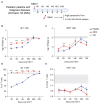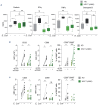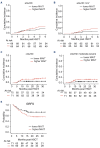Mucosal-associated invariant T cells are functionally impaired in pediatric and young adult patients following allogeneic hematopoietic stem cell transplantation and their recovery correlates with clinical outcomes
- PMID: 38813718
- PMCID: PMC11443409
- DOI: 10.3324/haematol.2023.284649
Mucosal-associated invariant T cells are functionally impaired in pediatric and young adult patients following allogeneic hematopoietic stem cell transplantation and their recovery correlates with clinical outcomes
Abstract
Mucosal-associated invariant T (MAIT) cells are innate-like T cells implicated in the response to fungal and bacterial infections. Their contribution to restoring T-cell immunity and influencing hematopoietic stem cell transplant (HSCT) outcomes remains poorly understood. We retrospectively studied MAIT-cell recovery in 145 consecutive children and young adults with hematologic malignancies undergoing allogeneic (allo)-HSCT between April 2019 and May 2022, from unrelated matched donor (MUD, N=52), with standard graft-versus-host-disease (GvHD) prophylaxis, or HLA-haploidentical (Haplo, N=93) donor after in vitro αβT/CD19-cell depletion, without post-HSCT pharmacological prophylaxis. With a median follow-up of 33 months (range, 12-49 months), overall survival (OS), disease-free survival (DFS), and non-relapse mortality (NRM) were 79.5%, 72%, and 7%, respectively; GvHD-free relapse-free survival (GRFS) was 63%, while cumulative incidence of relapse was 23%. While αβT cells were reconstituted 1-2 years post HSCT, MAIT cells showed delayed recovery and prolonged functional impairment, characterized by expression of activation (CD25, CD38), exhaustion (PD1, TIM3) and senescence (CD57) markers, and suboptimal ex vivo response. OS, DFS, and NRM were not affected by MAIT cells. Interestingly, higher MAIT cells at day +30 correlated with higher incidence of grade II-IV acute GvHD (19% vs. 7%, P=0.06). Furthermore, a greater MAIT-cell count tended to be associated with a higher incidence of chronic GvHD (cGvHD) (17% vs. 6%, P=0.07) resulting in lower GRFS (55% vs. 73%, P=0.05). Higher MAIT cells also correlated with greater cytomegalovirus (CMV) reactivation and lower late blood stream infections (BSI) (44% vs. 24%, P=0.02 and 9% vs. 18%, P=0.08, respectively). Future studies are needed to confirm the impact of early MAIT-cell recovery on cGvHD, CMV reactivation, and late BSI.
Figures






References
-
- Jenq RR, Van Den Brink MRM. Allogeneic haematopoietic stem cell transplantation: individualized stem cell and immune therapy of cancer. Nat Rev Cancer. 2010;10(3):213-221. - PubMed
-
- Velardi E, Clave E, Arruda LCM, Benini F, Locatelli F, Toubert A. The role of the thymus in allogeneic bone marrow transplantation and the recovery of the peripheral T-cell compartment. Semin Immunopathol. 2021;43(1):101-117. - PubMed
-
- Bartelink IH, Belitser SV, Knibbe CAJ, et al. . Immune reconstitution kinetics as an early predictor for mortality using various hematopoietic stem cell sources in children. Biol blood Marrow Transplant. 2013;19(2):305-313. - PubMed
MeSH terms
LinkOut - more resources
Full Text Sources
Research Materials
Miscellaneous

